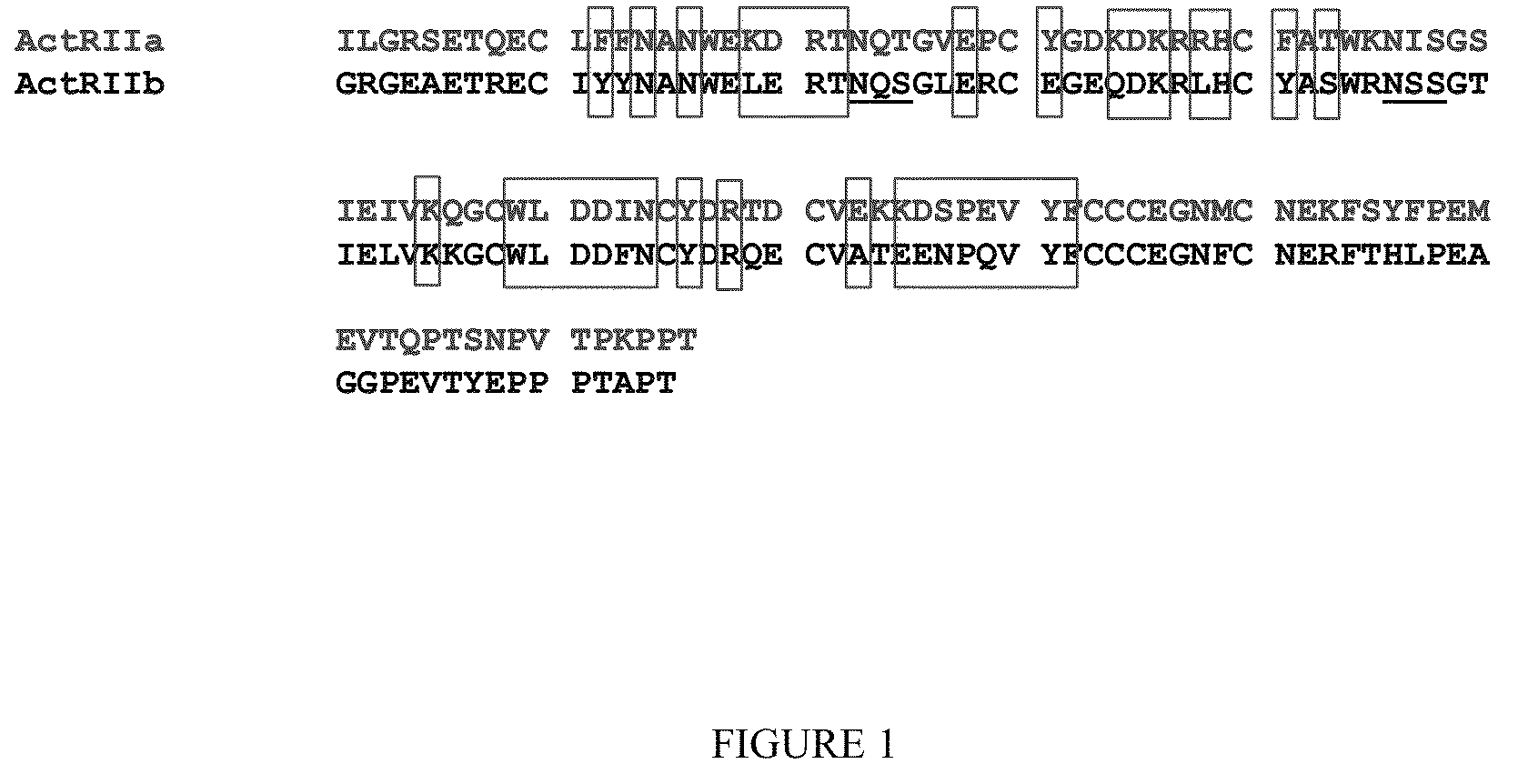Methods and compositions for treating ineffective erythropoiesis
- Summary
- Abstract
- Description
- Claims
- Application Information
AI Technical Summary
Benefits of technology
Problems solved by technology
Method used
Image
Examples
example 1
Generation of a GDF Trap
[0193]Applicants constructed a GDF Trap as follows. A polypeptide having a modified extracellular domain of ActRIIB with greatly reduced activin A binding relative to GDF11 and / or myostatin (as a consequence of a leucine-to-aspartate substitution at position 79 in SEQ ID NO: 1) was fused to a human or mouse Fc domain with a minimal linker (three glycine amino acids) in between. The constructs are referred to as ActRIIB(L79D 20-134)-hFc and ActRIIB(L79D 20-134)-mFc, respectively. Alternative forms with a glutamate rather than an aspartate at position 79 performed similarly (L79E). Alternative forms with an alanine rather than a valine at position 226 with respect to SEQ ID NO: 7, below were also generated and performed equivalently in all respects tested. The aspartate at position 79 (relative to SEQ ID NO: 1, or position 60 relative to SEQ ID NO: 7) is highlighted in gray below. The valine at position 226 relative to SEQ ID NO: 7 is also highlighted in gray b...
example 2
Bioassay for GDF-11 and Activin-Mediated Signaling
[0201]An A-204 Reporter Gene Assay was used to evaluate the effects of ActRIIB-Fc proteins and GDF Traps on signaling by GDF-11 and Activin A. Cell line: Human Rhabdomyosarcoma (derived from muscle). Reporter vector: pGL3(CAGA)12 (Described in Dennler et al, 1998, EMBO 17: 3091-3100). The CAGA12 motif is present in TGF-Beta responsive genes (PAI-1 gene), so this vector is of general use for factors signaling through Smad2 and 3.
[0202]Day 1: Split A-204 cells into 48-well plate.
[0203]Day 2: A-204 cells transfected with 10 ug pGL3(CAGA)12 or pGL3(CAGA)12(10 ug)+pRLCMV (1 ug) and Fugene.
[0204]Day 3: Add factors (diluted into medium+0.1% BSA). Inhibitors need to be preincubated with Factors for 1 hr before adding to cells. 6 hrs later, cells rinsed with PBS, and lyse cells.
[0205]This is followed by a Luciferase assay. In the absence of any inhibitors, Activin A showed 10 fold stimulation of reporter gene expression and an ED50˜2 ng / ml. G...
example 3
GDF-11 Inhibition by N-Terminal and C-Terminal Truncations
[0207]Variants of ActRIIB(20-134)-hFc with truncations at the N-terminus and / or C-terminus were generated and tested for activity as inhibitors of GDF-11 and activin. The activities are shown below (as measured in conditioned media):
C-Terminal ActRIIB-hFc Truncations:
[0208]
IC50 (ng / mL)GDF-11ActivinActRIIB(20-134)-hFc4522ActRIIB(20-132)-hFc8732ActRIIB(20-131)-hFc12044ActRIIB(20-128)-hFc130158
[0209]As can be seen, truncations of three (ending with . . . PPT), six (ending with . . . YEP) or more amino acids at the C-terminus causes a threefold or greater decrease in the activity of the molecule. The truncation of the final 15 amino acids of the ActRIIB portion causes a greater loss of activity (see WO2006 / 012627).
[0210]Amino terminal truncations were made in the background of an ActRIIB(20-131)-hFc protein. The activities are shown below (as measured in conditioned media):
N-Terminal ActRIIB-hFc Truncations:
[0211]
IC50 (ng / mL)GDF-...
PUM
 Login to View More
Login to View More Abstract
Description
Claims
Application Information
 Login to View More
Login to View More - R&D
- Intellectual Property
- Life Sciences
- Materials
- Tech Scout
- Unparalleled Data Quality
- Higher Quality Content
- 60% Fewer Hallucinations
Browse by: Latest US Patents, China's latest patents, Technical Efficacy Thesaurus, Application Domain, Technology Topic, Popular Technical Reports.
© 2025 PatSnap. All rights reserved.Legal|Privacy policy|Modern Slavery Act Transparency Statement|Sitemap|About US| Contact US: help@patsnap.com



